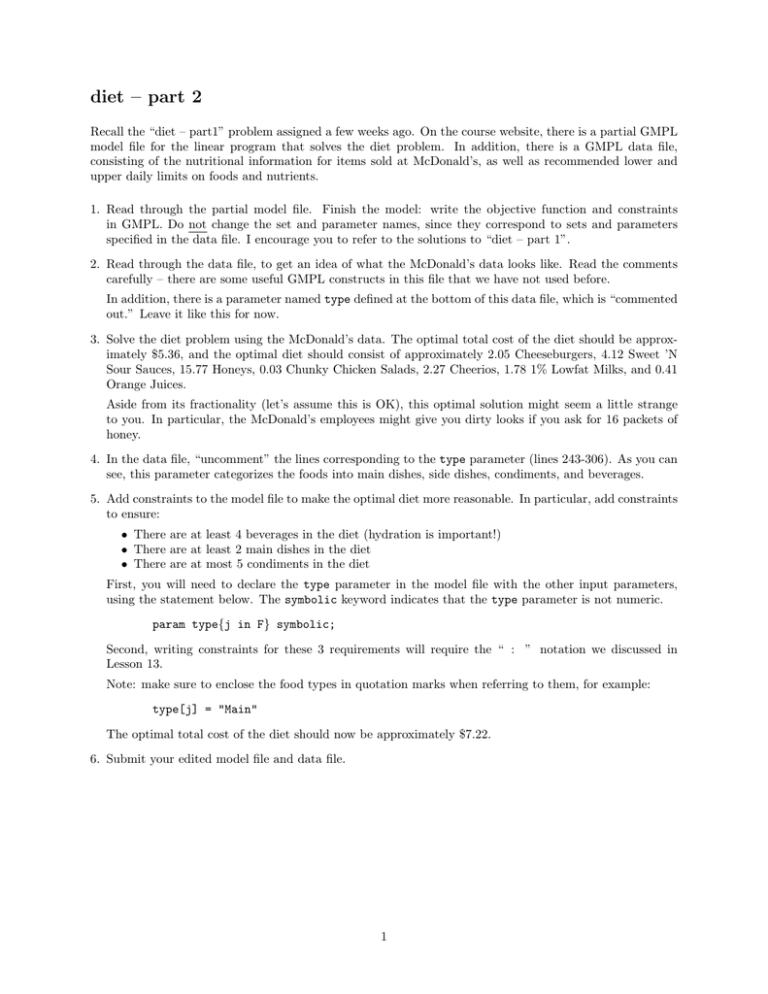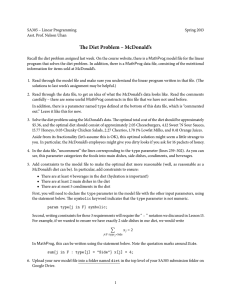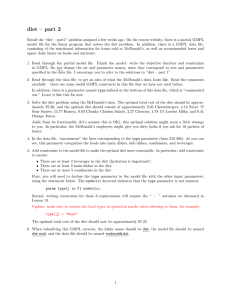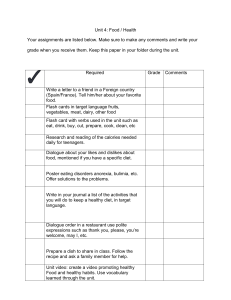diet – part 2
advertisement

diet – part 2
Recall the “diet – part1” problem assigned a few weeks ago. On the course website, there is a partial GMPL
model file for the linear program that solves the diet problem. In addition, there is a GMPL data file,
consisting of the nutritional information for items sold at McDonald’s, as well as recommended lower and
upper daily limits on foods and nutrients.
1. Read through the partial model file. Finish the model: write the objective function and constraints
in GMPL. Do not change the set and parameter names, since they correspond to sets and parameters
specified in the data file. I encourage you to refer to the solutions to “diet – part 1”.
2. Read through the data file, to get an idea of what the McDonald’s data looks like. Read the comments
carefully – there are some useful GMPL constructs in this file that we have not used before.
In addition, there is a parameter named type defined at the bottom of this data file, which is “commented
out.” Leave it like this for now.
3. Solve the diet problem using the McDonald’s data. The optimal total cost of the diet should be approximately $5.36, and the optimal diet should consist of approximately 2.05 Cheeseburgers, 4.12 Sweet ’N
Sour Sauces, 15.77 Honeys, 0.03 Chunky Chicken Salads, 2.27 Cheerios, 1.78 1% Lowfat Milks, and 0.41
Orange Juices.
Aside from its fractionality (let’s assume this is OK), this optimal solution might seem a little strange
to you. In particular, the McDonald’s employees might give you dirty looks if you ask for 16 packets of
honey.
4. In the data file, “uncomment” the lines corresponding to the type parameter (lines 243-306). As you can
see, this parameter categorizes the foods into main dishes, side dishes, condiments, and beverages.
5. Add constraints to the model file to make the optimal diet more reasonable. In particular, add constraints
to ensure:
• There are at least 4 beverages in the diet (hydration is important!)
• There are at least 2 main dishes in the diet
• There are at most 5 condiments in the diet
First, you will need to declare the type parameter in the model file with the other input parameters,
using the statement below. The symbolic keyword indicates that the type parameter is not numeric.
param type{j in F} symbolic;
Second, writing constraints for these 3 requirements will require the “ : ” notation we discussed in
Lesson 13.
Note: make sure to enclose the food types in quotation marks when referring to them, for example:
type[j] = "Main"
The optimal total cost of the diet should now be approximately $7.22.
6. Submit your edited model file and data file.
1







